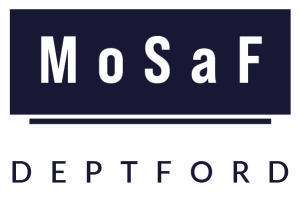The Past, Present & Future of Convoys Wharf – Deptford’s Dockyard
As a physical link to Deptford’s maritime past, including the transatlantic slave trade, there’s debate around how Convoys Wharf (the site of Deptford Dockyard) should be developed. The land is now owned by a developer, Convoys Properties Ltd., and the company was granted outline planning consent for mixed-use development back in 2014. There are proposals for very tall buildings, 3,500 new homes, and a refurbishment of a Grade II listed building on the site.As of now, in 2023, it is brownfield and stands derelict. MōSaF, along with many others, thinks that due respect needs to be paid to this historic place and that Deptford’s old dockyard should reflect the needs and interests of the community which lives here. Voice4Deptford, for example, is a community group campaigning for an inclusive development of Convoys Wharf. MōSaF would like a space in the Grade II building. Aside from the present controversy however, a lot has happened on the site over its long history. Here’s Convoys Wharf 500 year history…
A Brief History of Convoys Wharf
Convoys Wharf was the second Royal Dockyard. The dockyard was created in 1513 at the decree of Henry VIII to build vessels for the Tudor Navy, which would become the Royal Navy. With the need to protect England against the threat of invasion and war, naval ships were built and repaired here. Its original name was the King’s Yard.
This isn’t Convoys Wharf’s only royal connection. In 1698, Tsar Peter I of Russia – founder of St. Petersburg – visited the dockyard as a young man to learn about shipbuilding and seamanship. He stayed at the home of seventeenth-century diarist, John Evelyn; today the remains of his Sayes Court manor house, garden and park are encompassed by the Convoys Wharf site.[1]
The dockyard’s connection to the transatlantic slave trade began with the ships built there. John Hawkins (1532-1595) – an admiral in Elizabeth I’s Navy – was the first English trader in enslaved people to operate in the triangular trade. He lived and worked in Deptford. Others began to recognise the profit he was making from the labour of enslaved people and, chasing financial rewards, established a thriving shipbuilding industry in Deptford. From the royal dockyard, naval ships were used to convoy slave ships and to protect the Caribbean plantation economy system. You can read more about the transatlantic slave trade here.
After the slave trade was abolished in the British Empire in 1807, the dockyard was closed from 1830 until 1844. It was then that a Parliamentary Committee recommended that the dockyard should be officially shut down. This recommendation was accepted, and the dockyard stopped operating in May 1869. It was only a few years later, however, that the site reopened as an animal import market, mainly importing cattle.
Many decades later, during the Second World War, the site suffered bomb damage, and several men died during the air raid. Memorial stones were created to commemorate the buildings destroyed by enemy action. The site was used most recently to import newsprint and other paper products, before being sold by News International Ltd in the mid-2000s.
Despite a varied history, archaeological digs have revealed that many of the major features of the dockyard still exist below ground level. This includes the great basin, mast ponds, five slipways and the double dry-dock where HMS Lenox was built in 1678. At the time, HMS Lenox was a state-of-the-art naval ship, named in honour of Charles II’s illegitimate son, Charles Lennox, Duke of Lennox. Today, the charity The Lenox Project aims to build and launch a full-size replica of the ship.
The Olympia Building
One of the most significant buildings on the site is the Olympia warehouse. This 1840s cast-iron building is Grade II listed for its architectural and historic interest. The substantial warehouse, with two sweeping roofs, was constructed by George Baker & Son over the second and third slipways in the dockyard. It meant that ships could be covered whilst being built before being led into the dockyard basin, rather than directly into the river. MōSaF, along with many other groups, is actively involved in discussions with the developer about the future use of the Olympia Building.
—–—
To learn more about our campaign to build a Museum of Slavery and Freedom in Deptford, keep an eye on our ‘What’s On’ page, discover four ways to be involved, and sign up to our quarterly emails here.
[1] Discover more about the Sayes Court community project here.
